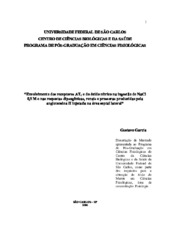| dc.contributor.author | Garcia, Gustavo | |
| dc.date.accessioned | 2016-06-02T19:22:46Z | |
| dc.date.available | 2007-07-11 | |
| dc.date.available | 2016-06-02T19:22:46Z | |
| dc.date.issued | 2006-03-10 | |
| dc.identifier.citation | GARCIA, Gustavo. Envolvimento dos receptores AT1 e do óxido nítrico na ingestão de NaCl 0,5 M e nas respostas dipsogênicas, renais e pressoras produzidas pela angiotensina II injetada na área septal lateral.. 2006. 39 f. Dissertação (Mestrado em Ciências Biológicas) - Universidade Federal de São Carlos, São Carlos, 2006. | por |
| dc.identifier.uri | https://repositorio.ufscar.br/handle/ufscar/1275 | |
| dc.description.abstract | In this study, we investigated the participation of the AT1 receptors and of the nitric
oxide (NO) into lateral septal area (LSA), on the water intake, 0,5 M NaCl intake,
natriuresis, diuresis and pressor response induced by injection of angiotensin II (ANG II) in
the same area. Male Holtzman rats were used weighing between 280 and 320 g, with
cannulae of stainless steel implanted stereotactically into the LSA. The ANG II (25 ng/0,5
µl) injected into LSA, induced water and sodium intake and increased the urinary volume,
sodium urinary excretion and arterial pressure when compared with the control group, that
received 0,15 M NaCl. The pretreatment with losartan (antagonist of the AT1 angiotensin
receptors) into LSA abolished the water intake, the sodium intake and the pressor effect
induced by ANG II. The losartan also reduced the increase of urinary volume and of the
sodium excretion induced by ANG II. The previous treatment with 7-nitroindazole (inhibit
of the nitric oxide synthase enzyme) abolished the water intake and the increase of urinary
volume, decreased the sodium intake and the natriuretic effect and no changed the pressor
effect induced by ANG II. The results show the involvement of the AT1 angiotensinergic
receptors and of the nitric oxide into LSA in the control of the cardiovascular and
hydroelectrolytic balance, beyond a possible interaction between nitrergic and
angiotensinergic mechanisms of the LSA in this control. | eng |
| dc.description.sponsorship | Financiadora de Estudos e Projetos | |
| dc.format | application/pdf | por |
| dc.language | por | por |
| dc.publisher | Universidade Federal de São Carlos | por |
| dc.rights | Acesso Aberto | por |
| dc.subject | Diencefalo | por |
| dc.subject | Angiotensina II | por |
| dc.subject | Óxido nítrico | por |
| dc.subject | Sistema nervoso central | por |
| dc.subject | Equilíbrio hidro-eletrolítico (Fisiologia) | por |
| dc.subject | Angiotensin II | eng |
| dc.subject | Nitric oxide | eng |
| dc.subject | Central nervous system | eng |
| dc.subject | Cardiovascular and hydroelectrolytic control | eng |
| dc.title | Envolvimento dos receptores AT1 e do óxido nítrico na ingestão de NaCl 0,5 M e nas respostas dipsogênicas, renais e pressoras produzidas pela angiotensina II injetada na área septal lateral | por |
| dc.type | Dissertação | por |
| dc.contributor.advisor1 | Saad, Wilson Abrão | |
| dc.contributor.advisor1Lattes | http://genos.cnpq.br:12010/dwlattes/owa/prc_imp_cv_int?f_cod=K4780321Z3 | por |
| dc.description.resumo | Nesse estudo, investigamos a participação dos receptores AT1 e do óxido nítrico
(NO) na área septal lateral (ASL), sobre a ingestão de água, ingestão de NaCl 0,5 M,
natriurese, diurese e resposta pressora induzida pela injeção de angiotensina II (ANG II) na
mesma área. Foram utilizados ratos Holtzman pesando de 280 a 320 g, com cânulas de aço
inoxidável implantadas estereotaxicamente na ASL. A ANG II (25 ng/0,5 µl) injetada na
ASL, induziu ingestão de água e de sódio e aumentou o volume urinário, excreção urinária
de sódio e pressão arterial quando comparado ao grupo controle, que recebeu NaCl 0,15 M.
O pré-tratamento com losartan (antagonista dos receptores angiotensinérgicos AT1) na ASL
aboliu a ingestão de água, a ingestão de sódio e o efeito pressor induzido pela ANG II. O
losartan também reduziu o aumento de volume urinário e da excreção de sódio induzidos
pela ANG II. O tratamento prévio com 7-nitroindazol (inibidor da enzima óxido nítrico
sintase) aboliu a ingestão de água e o aumento de volume urinário, diminuiu a ingestão de
sódio e o efeito natriurético e não modificou o efeito pressor induzido pela ANG II. Os
resultados mostram o envolvimento dos receptores angiotensinérgicos AT1 e do NO na
ASL no controle do equilíbrio hidroeletrolítico e cardiovascular, além de uma possível
interação entre mecanismos angiotensinérgicos e nitrérgicos da ASL nesse controle. | por |
| dc.publisher.country | BR | por |
| dc.publisher.initials | UFSCar | por |
| dc.publisher.program | Programa Interinstitucional de Pós-Graduação em Ciências Fisiológicas - PIPGCF | por |
| dc.subject.cnpq | CIENCIAS BIOLOGICAS::FISIOLOGIA | por |
